Kryten
Smeee heeeeed
When utahjazz7 was creating the excellent Heavy Cataphract unit, there were several suggestions about alternative helmets. Well, prompted by Xen, I have taken the liberty of using this animation to create two alternative figures.
(So they are not really new units, but just crude variations of utahjazzs unit)
Here is utahjazz7s original figure:-
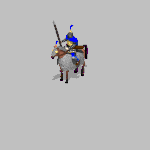
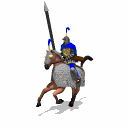
.and it can be found HERE.
This is perfect for the Byzantines during the period between 500 to 1200 AD.
And here is a Roman Cataphractari variation:-
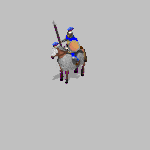
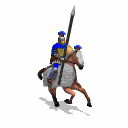
http://www.civfanatics.net/uploads5/Roman_Cataphractari.zip (950 Kb)
Suggested stats: 3-3-2, costs 60, requires iron, and is available with Construction.
Although the Late Roman Empire began using some Persian style cataphract units about 275 AD, these were very few until Constantine became sole emperor in 324 AD. The main problem with the Imperial Roman army from 0 to 300 AD was the fact that they had no reserves, as almost every legion and auxiliary was stationed on the frontier. This meant that if defeated, or if a major barbarian invasion had to be repelled, or during one of the many civil wars that plagued the empire, the only way of raising a large force was to strip troops from the boarder, thus leaving them weak and vulnerable to further attacks. The Late Roman army of 300 to 500 AD redressed this problem by creating reserve field armies called Comitani. Consisting of fast moving cavalry and Auxilia Palatinia infantry, these new field armies became the rapid mobile forces of the late empire, while the old legionaries and auxiliaries became little more than a frontier militia called Limitani. After 500 AD, following the collapse and fall of the Western Roman Empire, the East Roman/Byzantine Empire improved their cataphractari by arming them with bows in addition to their long lances.
And here is the Eastern Cataphract variation:-
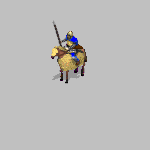
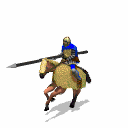
http://www.civfanatics.net/uploads5/Eastern_Cataphract.zip (820 Kb)
Suggested stats: 3-2-2, costs 50, requires iron, and is available with Monarchy. I also suggest that they be wheeled, so that cannot enter jungles, forests and mountains.
(Being so heavily armoured, these should really have a defence of 3 .but giving the Persians an mounted unit with a defence of 3 would encourage the AI and players to use them to defend cities with, which was certainly NOT their purpose)
Cataphracts were first used by the Seleucid Persians, so named because of the Macedonian general who took control of this region following the death of Alexander the Great. By 200 BC it was realised that Companion Horsemen, with their long lances, no shields, and with little armour, were too vulnerable in a melee. So the Seleucid king Antiochus III upgraded them by giving the riders full iron armour and the horses scale bronze armour. This made them far more formidable, although it also made them fairly slow and cumbersome for mounted troops. In effect, they became a phalanx on horseback, and suffered from many of the infantry phalanx disadvantages in that they were useless if disordered. Later, when the Parthians took control of Persia in about 140 BC, they continued to use cataphract troops alongside their traditional light horse archers, and used this combination to win a stunning victory over the Romans at the battle of Carrhae in 53 BC. Later still, in 240 AD, the native Persians regained control under the Sassanid dynasty, and they too continued to use cataphracts in their wars against the Romans, the Byzantines, and the emerging Arabs.
(This figure would also be suitable for the ancient Armenians, the Asia Minor breakaway Persian state of Pontus under Mithridates, the rebelling Roman client state of Palmyra, and the Scythian/southern Russian barbarians of the Crimea, such as the Alans, Rhoxalani and Sarmatians):-
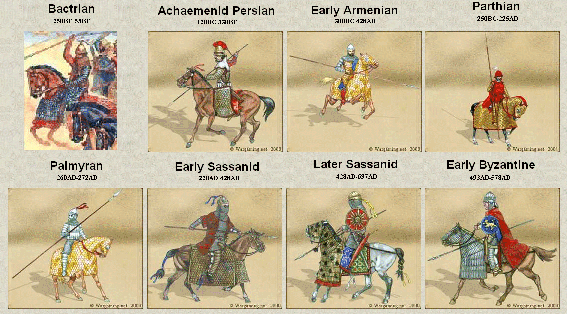
(So they are not really new units, but just crude variations of utahjazzs unit)
Here is utahjazz7s original figure:-


.and it can be found HERE.
This is perfect for the Byzantines during the period between 500 to 1200 AD.
And here is a Roman Cataphractari variation:-


http://www.civfanatics.net/uploads5/Roman_Cataphractari.zip (950 Kb)
Suggested stats: 3-3-2, costs 60, requires iron, and is available with Construction.
Although the Late Roman Empire began using some Persian style cataphract units about 275 AD, these were very few until Constantine became sole emperor in 324 AD. The main problem with the Imperial Roman army from 0 to 300 AD was the fact that they had no reserves, as almost every legion and auxiliary was stationed on the frontier. This meant that if defeated, or if a major barbarian invasion had to be repelled, or during one of the many civil wars that plagued the empire, the only way of raising a large force was to strip troops from the boarder, thus leaving them weak and vulnerable to further attacks. The Late Roman army of 300 to 500 AD redressed this problem by creating reserve field armies called Comitani. Consisting of fast moving cavalry and Auxilia Palatinia infantry, these new field armies became the rapid mobile forces of the late empire, while the old legionaries and auxiliaries became little more than a frontier militia called Limitani. After 500 AD, following the collapse and fall of the Western Roman Empire, the East Roman/Byzantine Empire improved their cataphractari by arming them with bows in addition to their long lances.
And here is the Eastern Cataphract variation:-


http://www.civfanatics.net/uploads5/Eastern_Cataphract.zip (820 Kb)
Suggested stats: 3-2-2, costs 50, requires iron, and is available with Monarchy. I also suggest that they be wheeled, so that cannot enter jungles, forests and mountains.
(Being so heavily armoured, these should really have a defence of 3 .but giving the Persians an mounted unit with a defence of 3 would encourage the AI and players to use them to defend cities with, which was certainly NOT their purpose)
Cataphracts were first used by the Seleucid Persians, so named because of the Macedonian general who took control of this region following the death of Alexander the Great. By 200 BC it was realised that Companion Horsemen, with their long lances, no shields, and with little armour, were too vulnerable in a melee. So the Seleucid king Antiochus III upgraded them by giving the riders full iron armour and the horses scale bronze armour. This made them far more formidable, although it also made them fairly slow and cumbersome for mounted troops. In effect, they became a phalanx on horseback, and suffered from many of the infantry phalanx disadvantages in that they were useless if disordered. Later, when the Parthians took control of Persia in about 140 BC, they continued to use cataphract troops alongside their traditional light horse archers, and used this combination to win a stunning victory over the Romans at the battle of Carrhae in 53 BC. Later still, in 240 AD, the native Persians regained control under the Sassanid dynasty, and they too continued to use cataphracts in their wars against the Romans, the Byzantines, and the emerging Arabs.
(This figure would also be suitable for the ancient Armenians, the Asia Minor breakaway Persian state of Pontus under Mithridates, the rebelling Roman client state of Palmyra, and the Scythian/southern Russian barbarians of the Crimea, such as the Alans, Rhoxalani and Sarmatians):-








 Yes boss.
Yes boss. 
 )
) , its no biggie though
, its no biggie though 
